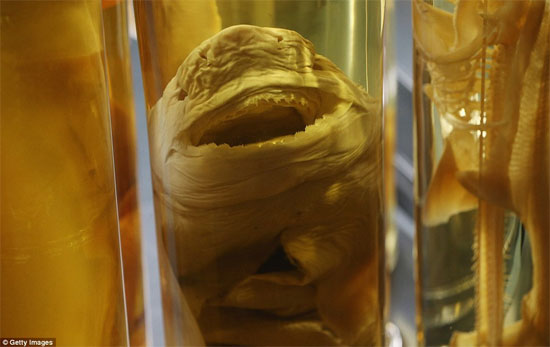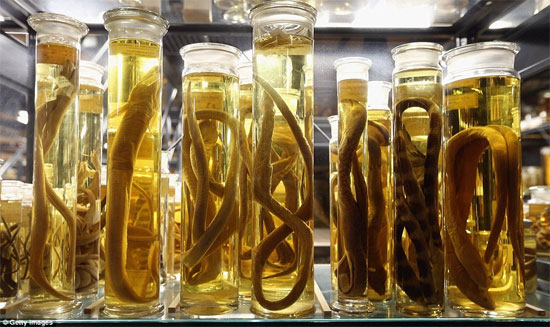Discovering animals 'never before seen in life'
Fossil dinosaur bones, hammerhead and tropical snake sharks . Millions of glass jars containing soaked solutions for these rare specimens have been exhibited for the first time in Germany. Certainly, there are animals you have never seen in your life!
The Museum of Natural History in Berlin, Germany currently holds the world's largest collection of animals with over one million species. 276,000 sample containers here need a massive three-story building to accommodate all the specimens.
The animals are carefully preserved in liquid containers in the Museum of Natural History in the city of Berlin, Germany. The interesting images below are only a very small part of the world's largest collection that this museum is holding.
The museum has its own building dedicated to the display of glass containers that hold specimens. The 3-storey building has the only interior with iron frames and transparent glass panels to accommodate 276,000 glass vases. The length of the average rack can be up to more than 11km. The number of animals preserved in the bottle is up to more than 1 million species.

A baby shark

Young snakes
This is the first time the Museum of Natural History in Berlin, Germany has officially allowed visitors to admire the huge collection of museums. Among these models, there are vases dating back to the 18th century.
The Museum of Natural History was bombed during World War II. The bomb spilled a pillar that caused this pillar to fall into glass containers containing specimens, causing numerous containers of specimens to crumble.
In 1995, the museum decided to modernize and overhaul the entire museum. The process has been carried out for 15 years, until 2010 to complete everything.

The world of animals.If you calculate the total length of the iron shelves containing glass bottles, the number could reach more than 11km.

Stingray.

A large part of the collection was destroyed by the bomb thrown at the museum in World War II.
Despite losing many specimens during the war, the Museum of Natural History today still holds the world's largest collection of animals with diverse animals in the wild.
For museums, this is an invaluable cultural asset, it cannot be replaced. They have been wonderfully collected over the past two centuries. Today, this collection still contains massive sources of information for biologists' research work on biodiversity and evolutionary steps.

A boy is looking at the eels

The amount of alcohol used in these sample containers is estimated at 81,880 liters.The specimens here are extremely diverse, there will certainly be animals that viewers first saw in life.

Tropical snakes with prey are still in their mouths.

The renovation and upgrading of the museum has just been completed in 2010.
Because of war-induced destruction, particularly the museum once bombed in World War II, many specimens were severely damaged. At the same time, the basic information for the lookup that is stuck on the glass jar is also lost when the broken bottle makes it difficult to match the information between the specimen and the related documents.
During the museum 'evacuation' of glass jars for repairs and upgrades, there were only 6 broken jars, which was a great success for the servants at the museum.
In addition, the site houses fossil dinosaur skeletons, especially the skeleton of Brachiosaurus, the world's largest dinosaur, up to 13m long.

A species of toad, living in Central Europe and West Asia (left).A convex eye fish (right).

Because of the extent to which the museum had suffered during the war, many specimens were no longer in an ideal state and information about the specimen was lost, making research impossible. The same complex and difficult.
Reference: Daily Mail
- The life secret of animals
- Animals take human life in the blink of an eye
- Discovering immortal animals on Earth
- NASA extends the list of life-like planets
- 3 scientific discoveries about people make you surprised
- Animals also have love life?
- Discovering evidence of Earth's oldest life
- Discovering life under thick ice in Antarctica
- Life animals 10,000 years, though
- Mistakes when eating can shorten life
- 10 animals that live the longest in the earth
- Discovering the sunshine about
 'Fine laughs' - Scary and painful torture in ancient times
'Fine laughs' - Scary and painful torture in ancient times The sequence of numbers 142857 of the Egyptian pyramids is known as the strangest number in the world - Why?
The sequence of numbers 142857 of the Egyptian pyramids is known as the strangest number in the world - Why? History of the iron
History of the iron What is alum?
What is alum? The secret in the 160-year-old painting has finally been decoded, surprising everyone.
The secret in the 160-year-old painting has finally been decoded, surprising everyone.  Overview of the Vietnam Military History Museum
Overview of the Vietnam Military History Museum  Experience the Vietnam Military History Museum with 360-degree photos
Experience the Vietnam Military History Museum with 360-degree photos  Priceless treasures bearing the mark of dynasties in China
Priceless treasures bearing the mark of dynasties in China  AI Helps Museum Animal Specimens Tell Stories
AI Helps Museum Animal Specimens Tell Stories  Overwhelmed by the array of planes, tanks and 'huge' weapons at the Vietnam Military History Museum
Overwhelmed by the array of planes, tanks and 'huge' weapons at the Vietnam Military History Museum 